UNION AND INTERSECTION OF SETS
Union of two sets :
The union of two sets contains all the elements contained in either set (or both sets).
The union is notated A ⋃ B.
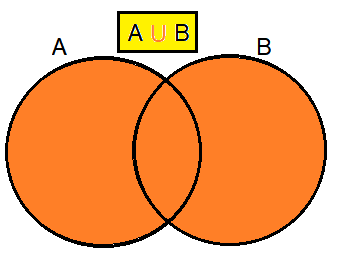
Intersection of two sets :
The intersection of two sets contains only the elements that are in both sets.
The intersection is notated A ⋂ B.
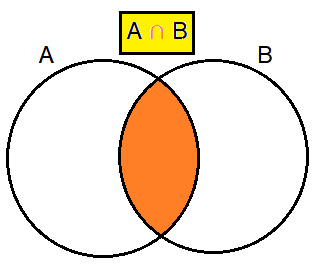
Problem 1 :
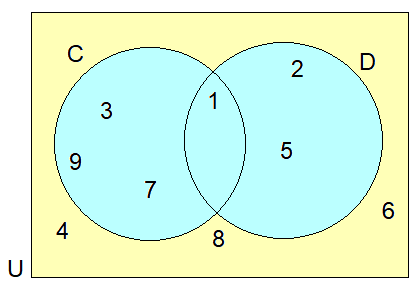
List :
|
i) Set C ii) Set D iii) Set U |
iv) Set C ∩ D v) Set C U D |
Solution :
i) Set C
The elements in set C = {1, 3, 7, 9}
ii) Set D
The elements in set D = {1, 2, 5}
iii) Set U
The universal set with all the elements in set
U = {1, 2, 3, 4, 5, 6, 7, 8, 9}
iv) Set C ∩ D
The common elements in set C and D is
C ∩ D = {1}
v) Set C U D
All the elements in sets C and D is
C U D = {1, 2, 3, 5, 7, 9}
Problem 2 :
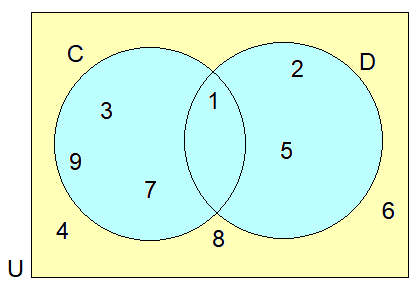
List :
|
(i) n(C) (ii) n(D) (iii) n(U) |
(iv) n(C ∩ D) (v) n(C U D) |
Solution :
(i) n(C)
The number of elements in set C is 4.
So, n(C) = 4
(ii) n(D)
The number of elements in set D is 3.
So, n(D) = 3
(iii) n(U)
The number of elements in universal set U is 9.
n(U) = 9
(iv) n(C ∩ D)
The number of common elements in sets C and D is 1.
n(C ∩ D) = 1
(v) n(C U D)
The number of all elements in sets C and D is 6.
n(C U D) = 6
Problem 3 :
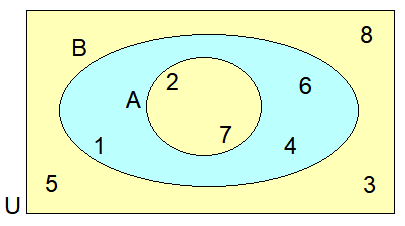
List :
|
(i) Set A (ii) Set B (iii) Set U |
(iv) Set A ∩ B (v) Set A U B |
Solution :
(i) A = {2, 7}
(ii) B = {1, 4, 6, 2, 7}
(iii) U = {1, 2, 3, 4, 5, 6, 7, 8}
(iv) A ∩ B = {2, 7}
(v) A U B = {1, 2, 4, 6, 7}
Problem 4 :
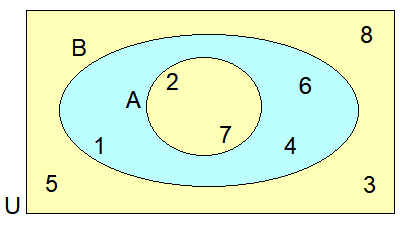
Find :
|
(i) n(A) (ii) n(B) (iii) n(U) |
(iv) n(A ∩ B) (v) n(A U B) |
Solution :
(i) n(A)
The number of elements in set A is 2.
So, n(A) = 2
(ii) n(B)
The number of elements in set B is 5.
So, n(B) = 5
(iii) n(U)
The number of elements in universal set U is 8.
n(U) = 8
(iv) n(A ∩ B)
The number of common elements in sets A and B is 2.
n(A ∩ B) = 2
(v) n(A U B)
The number of all elements in sets A and B is 5.
n(A U D) = 5
Problem 5 :
Consider U = {x│x ≤ 12, x € Z+},
A = {2, 7, 9, 10, 11} and B = {1, 2, 9, 11, 12}.
a) Show these sets on a Venn diagram.
b) List the elements of :
(i) A ∩ B
(ii) A U B
(iii) B’
c) Find :
|
(i) n(A) (ii) n(B’) |
(iii) n(A ∩ B) (iv) n(A U B) |
Solution :
a)
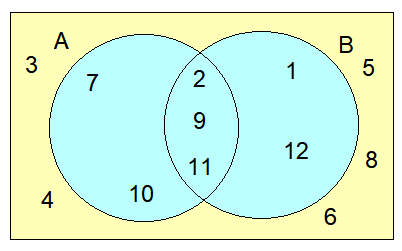
b)
(i) A ∩B = {2, 9, 11}
(ii) A U B = {1, 2, 7, 9, 10, 11, 12}
(iii) B’
The elements which do not belong to set B is
B’ = {3, 4, 5, 6, 7, 8, 10}
c)
(i) n(A) = 5
(ii) The number of elements which do not belong to set B is B’ = 7
(iii) n(A ∩ B) = 3
(iv) n(A U B) = 7
Recent Articles
-
Finding Range of Values Inequality Problems
May 21, 24 08:51 PM
Finding Range of Values Inequality Problems -
Solving Two Step Inequality Word Problems
May 21, 24 08:51 AM
Solving Two Step Inequality Word Problems -
Exponential Function Context and Data Modeling
May 20, 24 10:45 PM
Exponential Function Context and Data Modeling